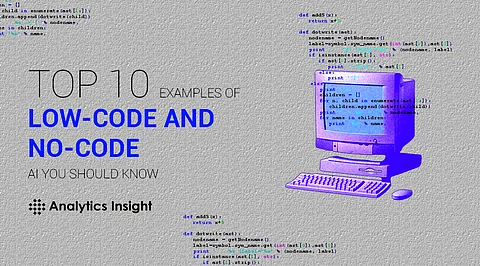
- Insights
- Cryptocurrencies
- Stocks
- White Papers
- Industry
- Geography
- Insights
- Cryptocurrencies
- Stocks
- White Papers
- Industry
- Geography


Intro: The emergence of a new generation of Low-Code and No-Code AI tools and platforms creates applications that leverage machine learning in innovative ways. Artificial Intelligence can help design web services and customer-facing apps to coordinate sales and marketing campaigns. The use of Low-Code and No-Code requires minimal coding knowledge.
The low-code and no-code AI tools represent a long goal in computer science to automate manual coding. Low-code is a software development technique that promotes faster app deliveries with little to no coding required and low-code platforms are software tools that allow the visual development of apps using a GUI interface, whereas, no-code is a software design system that implements software without writing a line of code. No-Code AI tool has an easy-to-use UI and drag-and-drop option. Low-Code and no-code tools to create AI applications without writing technical code. Here are the top 10 Examples of low-code and no-code AI tools:
Akkio is the fastest, easiest way to build and deploy AI with business data and without coding. It requires no coding or data science skills. It enables the creation of AI-powered workflows with a focus on enabling them to be quickly deployed and assessed. It boasts a strong suite of integrations like industry-standard data platforms like snowflake and Hubspot Marketing tools.
Amazon SageMaker is a managed service in Amazon Web Services that provides tools to build, train and deploy machine learning models for predictive analytics applications. The platform automates the tedious work of building an AI pipeline. SageMaker gives users a selection of templates for the most popular types of ML apps that businesses are likely to benefit from. Amazon SageMaker uses common algorithms and other tools to accelerate the ML process.
Apple CreateML provides a simple API for training machine learning models. It offers simple drag-and-drop functionality to create iOS applications like sound classification, image recognition, etc. Using an iPhone camera and microphone, data can be collected. It quickly builds and trains Core ML models on Mac with no code.
DataRobot is a machine learning platform for automating, assuring, and accelerating predictive analytics, helping data scientists and analysts build and deploy accurate predictive models in a fraction of the time. This cloud-based platform offers tools to automate data preparation and building and deploying algorithms. A highlighting feature is its focus on explainable AI that aims to inspire trust in the insights and decisions it produces.
Google AutoML enables developers with limited machine learning expertise to train high-quality models specific to their business needs. It is Google's first No-Code solution with a simple graphic interface, computer vision, and natural language processing. Google AutoML also runs in Google Cloud.
Google Teachable Machine is a web-based tool that makes creating machine learning models fast, easy, and accessible to everyone. This beginner-friendly tool has simple, straightforward tutorials that can guide you through the process of training algorithms to classify and categorize data. The tool is most useful as a teaching aid for getting to grips with the basics.
NanoNets is a machine learning API for developers that requires 1/10th of data and no machine learning expertise to train a model. Upload the data, wait for a few minutes, and get a model you can query over their easy-to-use cloud API. This AI platform automates and speeds up the process of extracting structured or semi-structured data from documents.
Microsoft Lobe is a free, easy-to-use Microsoft desktop application that allows you to build, manage, and use custom machine learning models. Lobe helps to create an image classification model to categorize images into labels that represent their content. It requires no coding skills.
AI is the fastest and easiest tool to build AI models in minutes, without writing code. It aims to simply plug in their data and start to reap the benefits of AI-powered analytics. It offers templates for time series analysis, predicting churn, risk scoring, fraud detection, and identifying cross-selling opportunities.
PyCaret is an open-source, low-code machine learning library in Python that automates machine learning workflows. It is an end-to-end machine learning and model management tool that exponentially speeds up the experiment cycle and makes you more productive. It provides several pre-configured functions that simplify tasks of data preparation, analytics, and model training.
